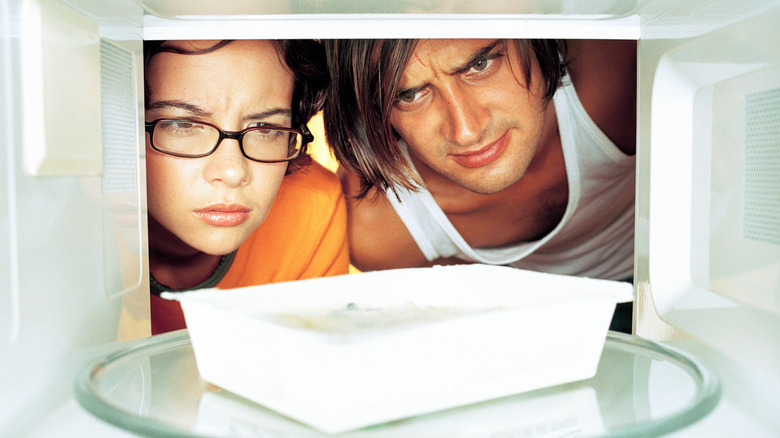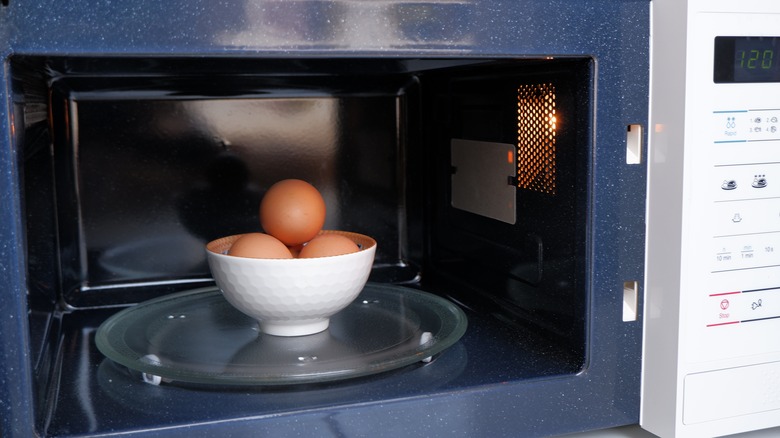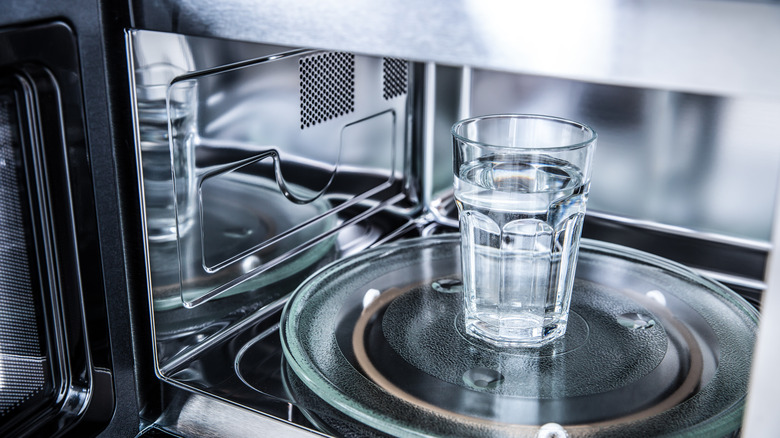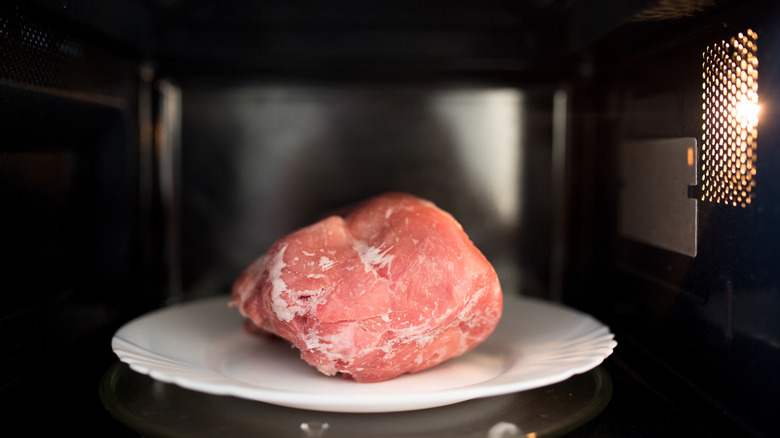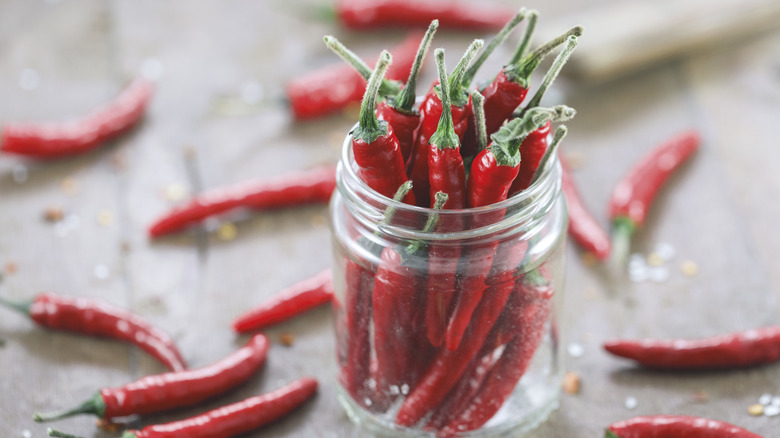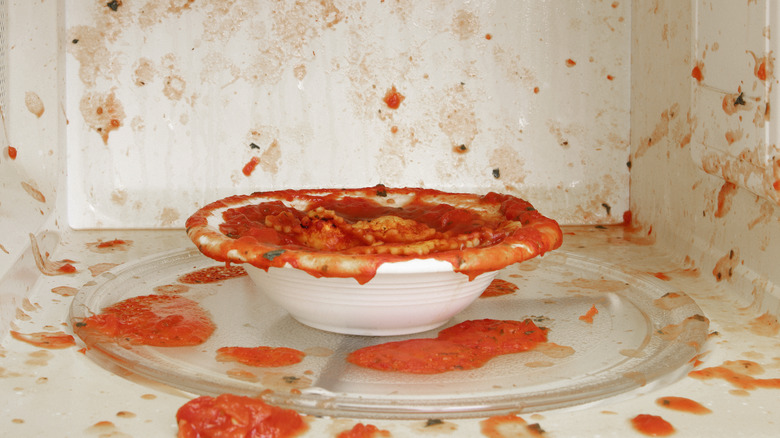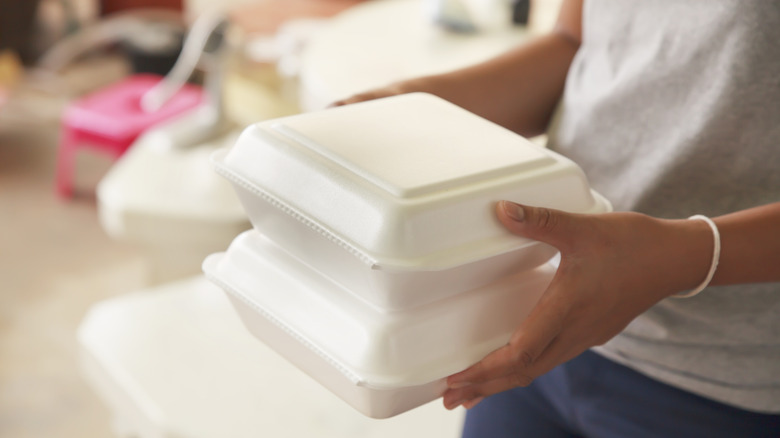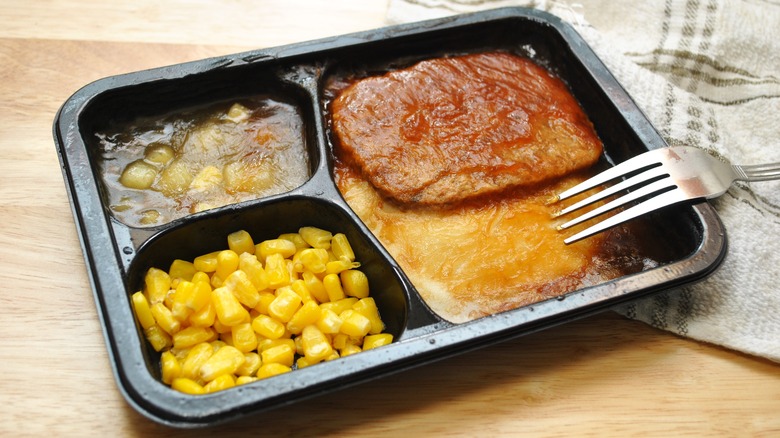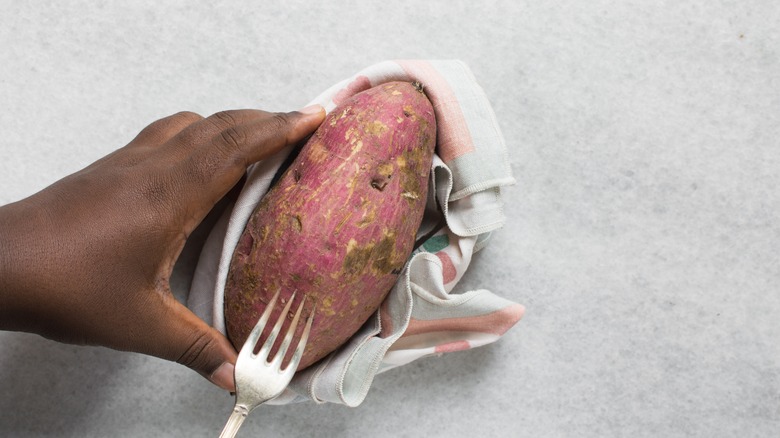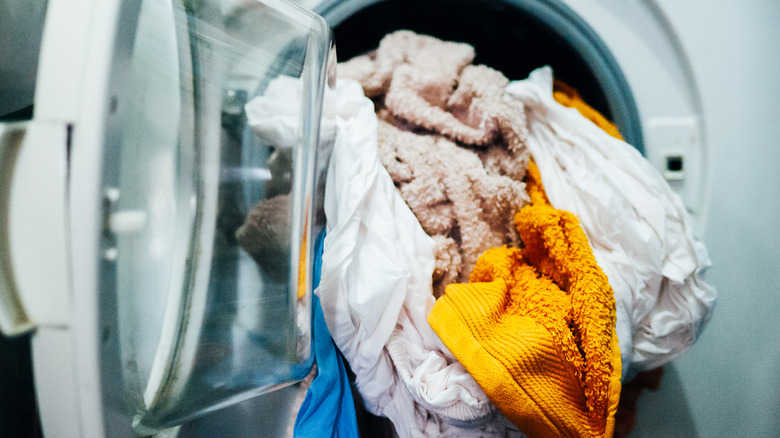12 Potential Microwave Disasters And How To Avoid Them
There is little doubt that microwaves are a game-changer in the kitchen. These nifty appliances are fast, convenient, and energy-efficient. From cooking up a feast to reheating leftovers, microwaves are now an essential gadget for modern living. Compact and quiet, they also fit seamlessly into small spaces, be it apartments, student dorms, or offices.
The first patent for a microwave oven was filed in 1945, with the early appliances standing around 6 feet tall and weighing over 750 pounds. Perhaps it's due to these dimensions that the gadget didn't start becoming popular in home kitchens until the 1970s. By then, advancements in technology had made microwaves smaller and more budget-friendly for the average household.
Modern microwaves come with a huge range of features, from different cooking modes to smart connectivity that lets users control them remotely. However, even though they have come a long way, microwaves still have their limitations. In fact, if used inappropriately, they can even pose safety risks. Ready to find out more about potential microwave disasters and how to avoid them? Keep reading.
Letting the microwave run empty can damage the appliance
Whether by accident or to test its limits, running your microwave without anything inside is never a good idea. There is a very simple reason for this. Microwaves generate electromagnetic waves, or energy waves, which then bounce around inside the appliance before being absorbed by the food and cooking it. However, if there is nothing in the microwave, these energy waves are absorbed by the appliance itself. This, in turn, can lead to overheating and cause damage to the magnetron, which produces microwave radiation. In the worst case scenario, the overheated components can ignite particles of food, debris, or grease inside the microwave, leading to a fire.
If you do happen to accidentally run your microwave without any food inside for a short period of time, there is no need to panic. According to GE Appliances, an empty microwave that has been switched on for less than five minutes should be fine — just be sure to let the appliance cool down before using it again. One way to test whether the microwave is still functioning is to use it to heat up a cup of water in a microwave-safe container for a minute. If the water is hot, all is probably in order. If the microwave was left running empty for a longer period than five minutes — or if you smell any unusual odors or see any visible signs of damage — it's best to have the appliance inspected by a professional.
Microwaving eggs in their shells can result in explosions
While it may seem fast and convenient, microwaving eggs in their shells is likely to leave you with a huge mess on your hands. This is due to the fact that microwaves cook food by agitating water molecules to generate heat, essentially heating the eggs from the inside. This creates steam, building up pressure inside the shell and potentially leading to a messy explosion inside the appliance. If things go really wrong, the egg can also explode once taken out of the appliance, leaving you with scalds and burns.
There are a few things you can do to safely prepare eggs in the microwave, and piercing the eggshell is definitely not one of them. While poking a hole in the shell can help to release some steam, it doesn't guarantee that the egg won't explode. If you want to microwave eggs with their shells intact, invest in a microwave egg cooker — a gadget designed to cook eggs evenly and safely using steam. Alternatively, you can make scrambled eggs, provided that you do so in a microwave-safe container. Finally, when microwaving entire egg yolks, always prick them with a fork to let the steam escape safely during the cooking process.
Superheating water can leave you with serious burns
Boiling a cup of water in the microwave may seem like a no-brainer. However, in reality, what may seemingly appear like a safe shortcut can be incredibly dangerous. When placed in the microwave, water can superheat, reaching temperatures above its boiling point without bubbling on the surface. Not only can this change the taste of water, giving it a flat or stale quality, but it can also result in a sudden eruption when the water is disturbed — this could happen when you pick up the mug, stir the water, or mix it with a dry ingredient like ground coffee.
The best way of avoiding a potential catastrophe is to always heat your water in a kettle or a saucepan. However, if this isn't possible and you are dying for a cup of coffee, microwaving water can still be an option, provided that you take some simple precautions. If you are planning to microwave water on a regular basis, buy a microwave-safe cup and stir the water before placing it in the appliance to help distribute any heat more evenly. You can also place a non-metal utensil like a wooden chopstick or coffee stirrer in the cup to give the steam bubbles a place to attach, reducing the risk of superheating.
Defrosting raw meat and poultry in the microwave can spread harmful bacteria
While thawing meat and poultry in the microwave may seem convenient, the practice can easily lead to a bad case of food poisoning. Defrosting protein in the microwave can cause uneven thawing, with the exterior of the protein reaching temperatures where bacteria can thrive before its interior is fully defrosted. According to the USDA, the so-called "danger zone" for bacterial growth lies between 40 F and 140 F.
To avoid any issues, it's best to only defrost small pieces of meat or poultry in the microwave. It's also important to cook the protein immediately after it has been defrosted, since letting it sit could let bacteria multiply on the partially cooked outer layers. When thawing meat and poultry in the microwave, always place them in a microwave-safe container to collect any juices that could otherwise contaminate the interior of the appliance.
The safest — and most widely recommended way — of thawing meat and poultry is in the refrigerator where it will remain under 40 F. The only caveat to this method is that it requires a little planning, as large cuts of meat can take a while to thaw. For example, defrosting a turkey takes approximately 24 hours for each 5 pounds of the bird.
Microwaving hot peppers can end in tears
Hot peppers don't come with a warning label. And while we all know to eat them with caution, not everybody is aware that putting them in the microwave can lead to an entirely different problem. When heated in the microwave, peppers release capsaicin, the compound that makes them spicy. As long as the microwave door is closed, the capsaicin will remain harmless. However, when you open the appliance, the vapor will hit your eyes, throat, and lungs. The level of pain you are likely to experience will depend on the type of hot pepper and how long you microwaved it.
Whether it's drying hot peppers or cooking a spicy stir fry, opt for methods that allow proper ventilation like stovetops or the oven. If you absolutely have to try the risky shortcut of using a microwave (although we don't recommend it), heed the advice of one Reddit user who says, "You can microwave dried chilis instead of [toasting] them in a skillet. If you microwave them too long you will end up pepper spraying your kitchen. I microwave the dried chilis five seconds at a time. Works like a charm. I've never done it with non dried chilis and I can't think of why one would do that."
Heating uncovered sauces in the microwave can create a huge mess
Whether it's tomato sauce or a thick curry, heating up sauces in an uncovered dish is likely to result in colorful splatters inside your microwave. Since microwaves work by heating up water molecules in food, any thick, liquid-based products can reach boiling point quickly. Being sticky and thick, sauces trap steam pockets beneath the surface, which can explode, coating your microwave walls with food. If this happens, it's important to clean the mess before the stains dry and harden, making them much more difficult to remove. In the most extreme case, the sauce might burst outside the microwave when stirred, resulting in burns.
The best way to heat up sauces is the traditional way — on the stove top. When doing this, be sure to use a small pan, as this will heat the sauce more evenly and make stirring easier to reduce the chances of any steam buildup. If warming the sauce on the stove top isn't an option, you can still reheat it in the microwave as long as you follow a couple of easy steps. It's important to place the sauce in a microwave-safe container and cover it loosely with a lid. Then, heat the sauce in 15- or 30-second intervals on high, stirring it gently between each interval.
Heating styrofoam and some plastics can leach harmful chemicals into your food
Some containers are not designed for microwave use, and putting them in the appliance can be downright dangerous to your health. While styrofoam is often used in takeout containers, reheating your leftovers without transferring them to microwave-safe kitchenware can expose your food to harmful substances that you definitely don't want to be consuming. This is because styrofoam melts in high temperatures, leaching chemicals like styrene into your meal. The Centers for Disease Prevention and Control has identified styrene as a possible carcinogen, especially in large amounts.
Unless they have been labeled microwave-safe, do not use plastic containers in the microwave, as they can also release chemicals into your food. These include one-time use plastics such as yogurt tubs, water bottles, and takeout trays. While they may seem relatively sturdy, heating plastics can release harmful micro-particles, such as BPA, into your dinner. According to PlastChem, more than 16,000 chemicals can be found in plastic products, with commonly-used plastics being linked to at least 400 "chemicals of concern."
Microwaving sealed containers or neglecting to poke holes in the film of ready-to-eat dinners can lead to explosions
Microwaving food often leads to significant steam build-up. Much like an egg microwaved in its shell, heating up food in a sealed container can lead to an explosion and a lengthy clean-up. This is why you should never microwave tightly sealed jars or cans of food. If you cook or reheat your food in a microwave-safe plastic container, never seal it completely — even if it does come with a lid. Instead, place the lid over the container loosely, leaving a small gap to let the steam escape during the cooking process. Alternatively, cover the container with a ceramic plate or even a damp paper towel.
Perhaps a self-proclaimed former T.V. chef explains this phenomenon best on Quora, saying, "Don't microwave anything of any substance in a closed container. Since the microwave makes the water molecules bounce against each other, creating heat, and steam as a by-product, steam must be released. [...] A closed container will build pressure and eventually something has to give against the pressure, and it will pop open, scattering food debris all over your microwave. [...] Use clear, plastic wrap, or place the lid on your container without it being retained in any way."
The same principle applies to T.V. dinners that are sealed with a plastic film. Despite being microwave-safe, the film has to be either pierced or peeled back before the meal is placed in the microwave to let the steam escape. While there is no ideal number of holes that guarantees perfect results, there should be enough ventilation to stop any pressure build up in the container.
Putting metal or aluminum foil in the microwave can spark a fire
Steel, iron, or copper kitchen utensils are a huge no-no when it comes to microwaves. The same goes for aluminum foil, which is nothing more than a very thin metal. When placed in the microwave, metals reflect electromagnetic waves in a haphazard way rather than absorb them, thus preventing the food from warming up. For example, because aluminum foil reflects microwaves, there is little sense in using it to wrap an item of food with the expectation that it will get warm in the appliance.
Placing metal objects or aluminum foil in the microwave can raise the internal temperature of the appliance and even lead to sparks. This, in turn, can damage the microwave's magnetron or other parts. It can even pose a serious fire hazard, burning a hole in the microwave wall and potentially igniting other materials in your kitchen and home.
Interestingly, some food manufacturers use thin layers of metal foil in microwaveable packaging — you may have seen this in the packaging for frozen pizza. This strategy takes advantage of metal's reflective properties, helping the areas of the food nearest to the foil cook faster. When it comes to pizza, this can result in a crisper crust than you would normally get from a microwaved pizza.
Failing to poke holes in potatoes can cause them to burst in the microwave
Microwaving unpeeled potatoes is a recipe for disaster. This is because just like a container with a tightly sealed lid, the outer layer of a vegetable can trap steam. This pressure build-up can cause the skin to suddenly break, splattering the produce all over the appliance. And if your hands happen to be in the line of fire, you could end up with a nasty burn.
Luckily, the solution to this problem is quick and easy — simply use a fork to make a few holes in the potato's skin before placing it in the appliance. This will create a vent for the steam to escape, leaving you with a perfectly cooked spud and a clean microwave. Notably, some types of potatoes explode in the microwave more frequently than others. For instance, potatoes with a thicker skin, such as Russet or Idaho potatoes, are more likely to build up pressure and explode if not pierced beforehand. In addition, younger potatoes have a higher water content, making it more likely that they will explode under pressure.
Drying clothes in the microwave is never a good idea
Those who think that the microwave can double as a traditional dryer for damp clothes are in for a rude awakening. This is because microwaves work very differently from tumble dryers. While dryers dry clothes by circulating heated air and the continuous movement of the drum, microwaves cook food by heating its water molecules with electromagnetic waves — a process that can result in inconsistent heating.
When you put wet clothes in a microwave, the water inside the fabric will heat up unevenly, creating hotspots in some parts of the clothing. This can very easily damage the garments, scorching or burning the fabric. To make matters worse, clothing made out of synthetic fibers, such as polyester or nylon, can melt in the microwave or even emit harmful chemicals into the air. Additionally, garments with metallic components, like zippers or buttons, can produce sparks and cause a fire in your microwave and home. Interestingly, it's the smaller items, such as socks or gloves, that are more likely to catch fire than larger items of clothing, which are more likely to just dry unevenly.
Microwaving paper products is a fire hazard
It's no secret that paper is highly flammable. As such, it shouldn't come as a surprise that paper products, such as paper bags, are likely to catch fire if placed in the microwave — just as they probably would in the oven. Paper bags are usually made from wood chips, and heat can easily dry them out and cause them to ignite. Some paper packaging also contains metal elements, which can lead to sparks, or inks that may contain toxic chemicals capable of contaminating your food.
Fortunately, not all paper packaging is unsafe for microwave use. Many food products come in paper containers designed to withstand microwave heat. If in doubt, it's best to look for a microwave-safe symbol on the packaging — this commonly comes in the form of wavy lines. A great example of this are popcorn bags, which are made with materials engineered to absorb electromagnetic waves. Other paper products that are generally safe for use in the microwave include wax paper, parchment paper, and even white paper towels.
